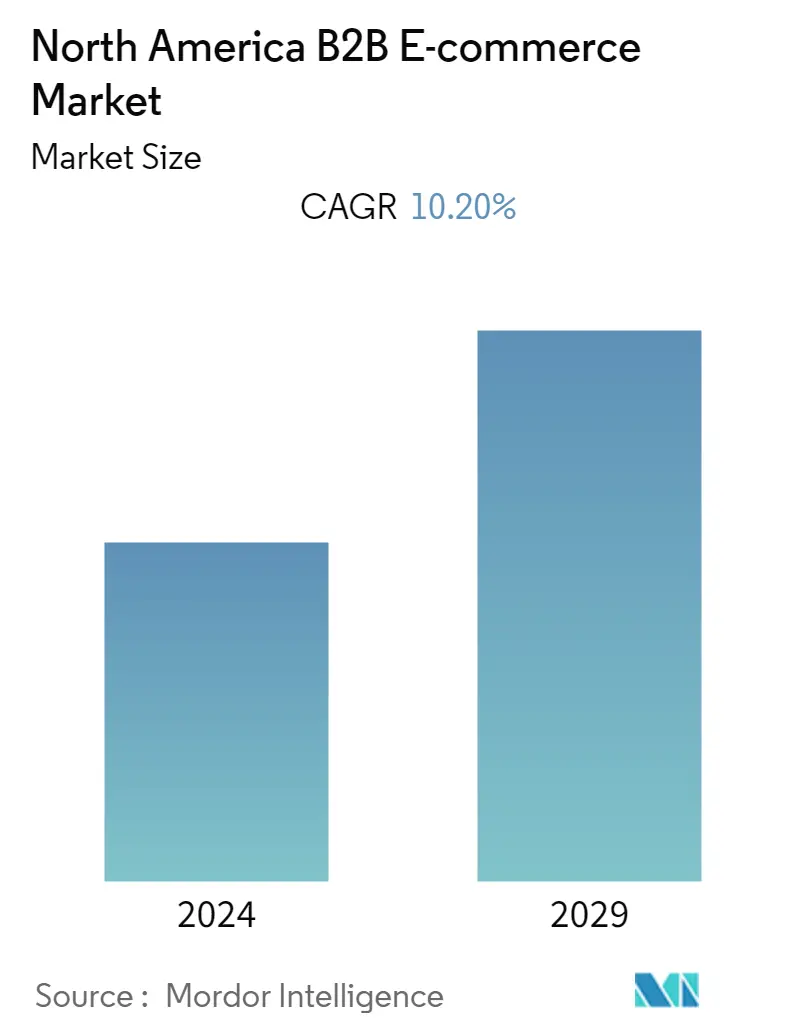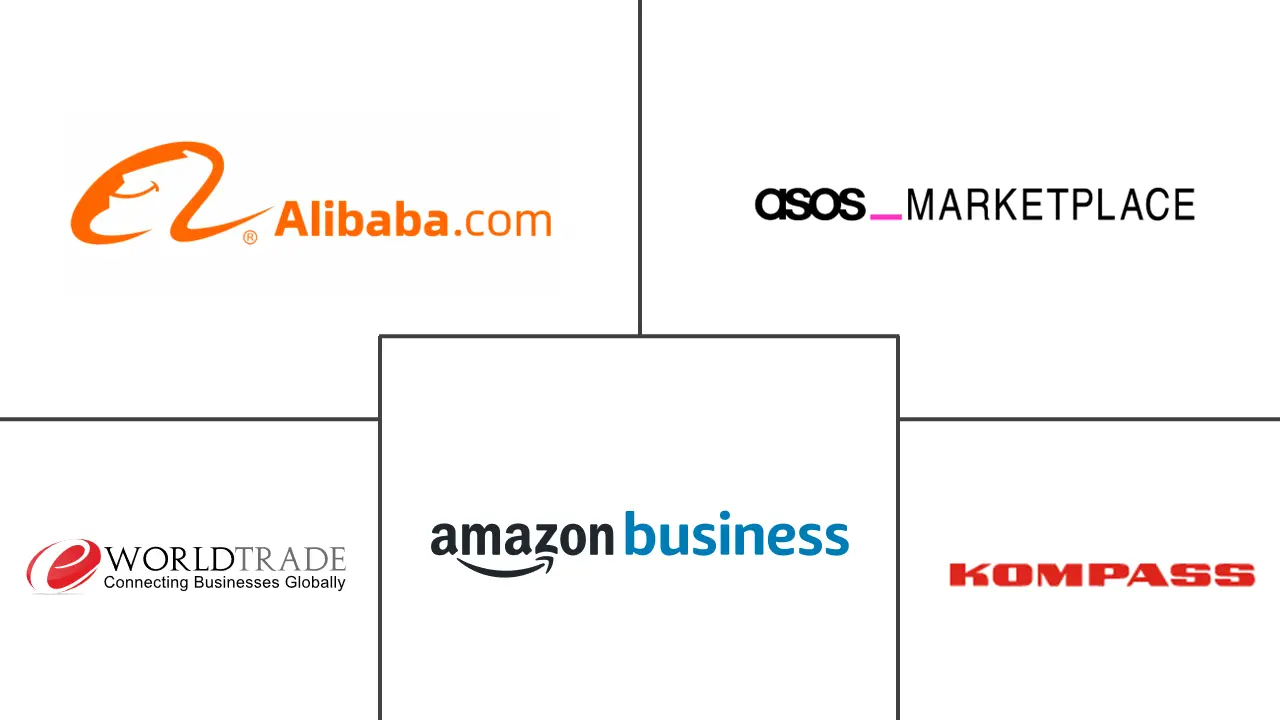Market Size of North America B2B E-commerce Industry

| Study Period | 2019 - 2029 |
| Base Year For Estimation | 2023 |
| Forecast Data Period | 2024 - 2029 |
| Historical Data Period | 2019 - 2022 |
| CAGR | 10.20 % |
| Market Concentration | Low |
Major Players
*Disclaimer: Major Players sorted in no particular order |
North America B2B E-commerce Market Analysis
North America B2B e-commerce market is expected to register a CAGR of 10.2% for the forecast period 2022-2027. The market is heavily influenced by digitalization and Industry 4.0 trends, with businesses of all sizes switching to digital modes of operations, digitalizing the majority of the aspects of the supply chain.
- According to Payments Canada, around 25% of the payments are conducted by debit or credit cards, with about 63% of transactions from POS credit and debit, and 4.2% of the payments from cheque and paper media in 2021. The shift in the preferable mode of payments supports the online payment modes offered by the e-commerce platform and also signifies the favorability of digital platforms for financial purposes.
- Modern buyers looking for customized solutions and suppliers avail the e-commerce platforms to approach different suppliers, popularizing the platforms. Hence, specialized B2B marketplaces are witnessing a significant boost in demand to cope with new technological advancements. This also boosts the competition and opportunities among the suppliers due to added reach and convenience through the e-commerce platforms.
- However, cybersecurity and data breaches constantly threaten the B2B e-commerce platforms and require stringent measures to ensure data security. For instance, according to The Daily Swig, in January 2022, the US e-commerce website, PulseTV detected a data breach, suspecting the exposure of more than 200,000 customer credit card records. The incident was detected by the end of December 2021, as the breach persisted between August 2021 and November 2021.
- Unlike most industries, the COVID-19 pandemic has benefitted North America's B2B e-commerce industry, motivating businesses to shift operations online and secure their function from the limited movement and availability of resources. B2B e-commerce platforms provided the perfect media to communicate with suppliers and wholesalers, aiding in the situation hit adversely by the limited movement across lockdowns. In the post-pandemic era, the companies benefit from the cost benefits and flexibility to greater availability of suppliers, with overall supply chain efficiency added.
North America B2B E-commerce Industry Segmentation
Business-to-business or B2B e-Commerce platforms allow buyers and suppliers to interact and arrange the deliverables leveraging the services offered by the platform. The scope of the report includes sales made through B2B e-commerce sites and e-procurement channels. However, EDI sales are not included as part of the scope.
The North America B2B E-commerce market is segmented by Channel (Direct sales and Marketplace sales) and Country.
| By Channel | |
| Direct Sales | |
| Marketplace Sales |
| By Geography | |
| United States | |
| Canada |
North America B2B E-commerce Market Size Summary
The North American B2B e-commerce market is experiencing significant growth, driven by the rapid digitalization and the adoption of Industry 4.0 trends. Businesses across the region are increasingly transitioning to digital operations, enhancing the efficiency of their supply chains. The shift towards online payment methods, as indicated by the preference for debit and credit card transactions, underscores the growing reliance on digital platforms for financial transactions. This trend is further bolstered by the demand for customized solutions, which has led to the rise of specialized B2B marketplaces. These platforms are becoming essential for suppliers seeking to expand their reach and leverage technological advancements, although they face challenges related to cybersecurity and data breaches.
The COVID-19 pandemic has accelerated the adoption of B2B e-commerce in North America, as companies sought to maintain operations amid restrictions and resource limitations. The pandemic highlighted the importance of online platforms for communication and transactions with suppliers and wholesalers, leading to increased cost efficiency and supply chain flexibility. The market is characterized by a fragmented landscape with intense competition among service providers, each striving to offer user-friendly interfaces and broader reach. Collaborations and partnerships, such as those between Alibaba.com and small businesses, are fostering growth by providing tools and resources to support online expansion. The ongoing evolution of retail e-commerce continues to influence the B2B sector, attracting new players and expanding market opportunities.
North America B2B E-commerce Market Size - Table of Contents
-
1. MARKET INSIGHTS
-
1.1 Market Overview
-
1.2 Market size (GMV) for the period of 2017-2027
-
1.3 Industry Attractiveness - Porter's Five Forces Analysis
-
1.3.1 Bargaining Power Of Suppliers
-
1.3.2 Bargaining Power Of Buyers
-
1.3.3 Threat Of New Entrants
-
1.3.4 Threat Of Substitutes
-
1.3.5 Intensity Of Competitive Rivalry
-
-
1.4 Assessment of the Impact of Covid-19 on the Market
-
-
2. MARKET SEGMENTATION
-
2.1 By Channel
-
2.1.1 Direct Sales
-
2.1.2 Marketplace Sales
-
-
2.2 By Geography
-
2.2.1 United States
-
2.2.2 Canada
-
-
North America B2B E-commerce Market Size FAQs
What is the current North America B2B E-commerce Market size?
The North America B2B E-commerce Market is projected to register a CAGR of 10.20% during the forecast period (2024-2029)
Who are the key players in North America B2B E-commerce Market?
Alibaba.com, ASOS Marketplace Limited, Amazon.com, Inc., KOMPASS and eworldtrade.com are the major companies operating in the North America B2B E-commerce Market.

